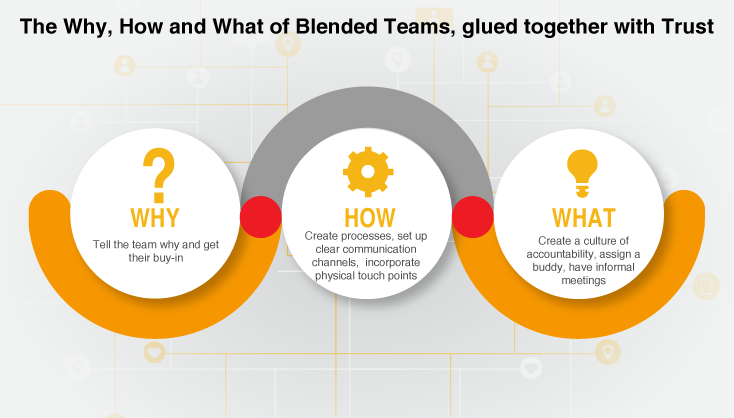How to make blended teams work featuring Saathealth
Covid-19 changed the way most companies work. There was a time when working from home was considered a luxury but with the pandemic taking over the planet, it became a necessity and forced companies to adapt quickly. Though this transition had its own challenges, with the lockdown coming to an end, there is a new problem that has cropped up. Parts of teams are being called back into the office while others continue to work from home; to ensure the continuance of social distancing, only 20-30% of attendance is present in the office at any given point in time.
With the lockdown coming to an end, there is a new problem that has cropped up. Parts of teams are being called back into the office while others continue to work from home.
This calls for ‘blended teams’. Now teams have to deal with two working environments simultaneously - remote working and in office. This poses a different set of challenges:
- Team members in-office might feel like they are contributing more than the ones working remotely.
- Managing time schedules to engage in virtual meetings could be challenging as a part of the team still has to deal with domestic chores and responsibilities.
- Teams might end up divided and working in silos.
- Informal networking between in-office team members might be better than people working remotely. This could cause dissonance between team members.
- In-office teams might have better access to different facilities that companies offer, including power back-ups, better internet speeds, refreshments, etc.
Today, FlexiBees is featuring https://www.saathealth.com/ who has been doing this seamlessly in their organization. Saathealth is an impact-focused social enterprise, building a digital ecosystem serving the parenting needs of emerging mobile users across India. As their team grew organically, they chose not to let geographical constraints determine the composition of their teams. They did not compromise on hiring the best talent that suited the job roles they had just because they didn’t live in the same city. Though this approach was not intentional, it gave them limitless opportunities to grow and work with different people across the country.
As expected they did have some bumps along the way. Initially their teams did end up working in silos or did not understand and appreciate what other teams were doing. The implementation of remote working itself is broader and deeper than most organizations realize and it needs a structured approach. Add a blended team to the mix and companies might have to plan better to avoid a dip in productivity, a loss of efficiency, and frustration among employees and stakeholders.
Read on to learn how Saathealth handled it and also how you can manage a blended workforce for your teams.

Tell the team why:
Leadership needs to define goals and take charge: Company leaders need to think about the why of implementing blended teams during the transition phase. They need to clearly figure out which roles can be done remotely and which roles need to be called into the office. This needs to be clearly communicated to the team to get their buy-in before starting the implementation. It would greatly help the flow of work if everyone understands and agrees with the need to implement a blended team, rather than just being told to do so. The next step would be to set up a clear set of guidelines for working in this new arrangement. This should not only focus on the why, but also on the what and the how.
Let them know how:
- Create a process: Processes can be boring, rigid, or uptight but a process will ensure smooth functioning where every team member knows what to do and how to go about it. Process should essentially define ‘how we work’. Set up a process and protocol for everything to avoid confusion, loss of time and cost of reworking. This can be evolving and can include a feedback loop for better refinement of how your team runs and what it needs.
- Ease of communication for day to day working: For an in-office team, you can always round up everyone for a quick all-hands meeting to get everyone on the same page. But with blended teams, you will need to rely on online apps and tools. Be it Slack, Microsoft Teams, Trello, or any other channel, ensure your team knows how to use it, are familiar with it, and uses it regularly to ensure clear communication and quick responses.
- Incorporate a few physical touch points: Once in a while, you can do in-person team meetings with the entire team or outbound training to help build camaraderie. This will also help everyone know each other better and create bonds between team members, which is so crucial in blended teams.
Reinforce the what:
Simply put, the ‘what’ is to get all the team members working together seamlessly, whether they are working from home or working remotely.
If you are a leader,
- Establish work timings and a structure so that everyone can build their routines around it. You could start your day with a quick stand-up meeting that could include remote as well as in-office team members.
- Create space and time for informal conversations and catch-ups between all team members.
- Create a culture of accountability - do not keep worrying if your team is actually working. An easy way to ensure things get done is to do Friday updates to get a progress check-in.
- Assign buddies, one team member working remotely with one team member who is in office. Let them pair up once a week for calls, informal chats, or more. You can keep rotating pairs so everyone gets to know each other better and the interactions can build camaraderie.
- Conduct one-on-one meetings with team members. If you have large groups, divide and schedule them, but talk to all your team members as frequently as possible so everyone feels heard.
If you are a team member,
- Whether you are working remotely or from your office, know that each team member plays a unique role in getting things done. Understand and appreciate this.
- If you are a remote worker, be available on the agreed channel of communication and respond as quickly as possible.
- Be accountable for the work assigned to you. This could mean sending in end-of-day reports, quick responses to requests or queries, or sharing your weekly agenda so your superior as well as your team is cued in.
Above all, trust is the secret sauce that can bring all this together. More often than not, it is overlooked and under-said.
Trust your team.
Trust plays a major role here. Remote working or working in blended teams will come to a halt when you cannot trust the person on the other end of the line. If team leaders are constantly checking on team members to know what they are up to, then they are losing precious productive time themselves and disrupting the workflow of their team members. This is not useful for anyone in the equation. Trust your team and let them do their job.
Covid-19 is compelling companies to try remote working and blended teams. This is our new normal for now. This is not just a temporary fix but companies could look into continuing this long after Covid is behind us. In fact, there may be many benefits to blended teams:
- Improved employee retention: Some people prefer working remotely/from home and with blended teams, this powerful choice can be given to them, thus improving retention.
- Lower costs: As a part of the team works remotely/from home, offices can be optimised, reducing real estate and facility costs. Secondly, if employees working remotely are living away from congested big cities, compensation policies can account for the reduced cost of living which can be a huge saving.
- No compromise on hiring the best talent: Geographical locations are no more a constraint. You can find the best talent anywhere in the world and include them in your team, without worrying about settling for talent that is only available locally.
Though it can be overwhelming at first, a structured approach and trust within your teams can ensure continued productivity and overall success.
__________________________
FlexiBees has provided companies, both startups and established players, with part-time talent for many projects and roles; across a variety of functions & skill-sets like Inside Sales, Business Development, Marketing, Digital Marketing, Public Relations, Investment Banking, Technology, Content Development, Writing, Graphic Design, etc. All these companies have benefited by being able to hire high quality talent at pricing optimised only for the hours of work they need. With the COVID-19 pandemic leading to businesses trying new approaches, strategies, MVPs, etc, part-time and project-based talent, that are high-quality and affordable, can help.
If you have a role requirement, take 2 minutes to fill our form and we will try our best to fulfil it for you, quickly and to your satisfaction.


